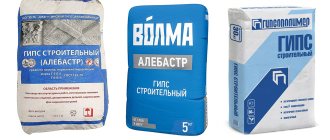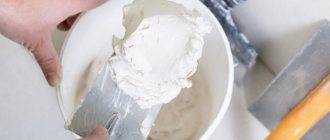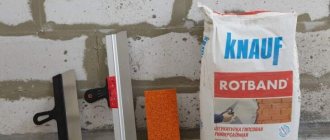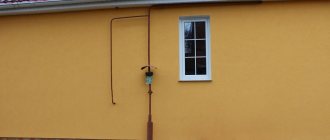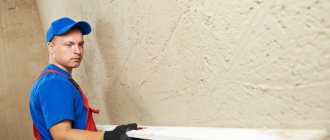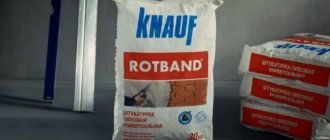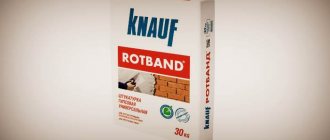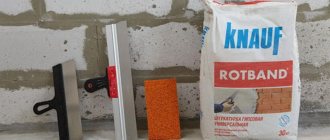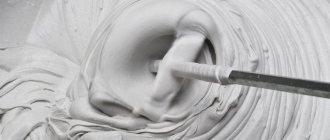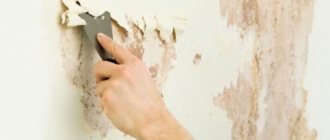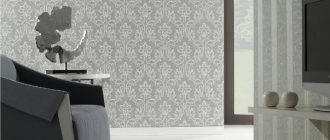Rotband gypsum plaster is one of the time-tested and master-tested materials, but it has time limitations in use. Rotband has a shelf life of 6 months.
Dry gypsum plaster Rotband Knauf is used for plastering ceilings and walls. It can be gray, white or even pinkish in color - this depends on the color of the natural gypsum used in the production and does not affect the quality.
Gypsum is a hygroscopic material and absorbs moisture from the environment very quickly. Therefore, even in untouched packaging, the manufacturer limits the shelf life to six months. This is the period within which the manufacturer guarantees the quality of the material.
Is it possible to use Rotband after the expiration date?
The use of such building materials is strictly not recommended. Even under ideal storage conditions, after opening the mixtures lose their original properties, and the result of the repair may be disappointing. Therefore, you should not wait until the expired contents of an open package are finished.
Important! Suitable materials must be used. Only they are guaranteed to perform their intended function and preserve the result of the repair for a long time.
Unusable plaster dries too quickly, it is difficult to distribute it evenly over the surface, this significantly complicates the work process. The situation is similar with putty.
The primer mixture also loses its anti-corrosion protective properties, which should be present for 3 years.
Peculiarities
Knauf plaster is purchased and praised for many reasons. The identity of the concepts “Knauf products” and “famous German quality” need not even be mentioned. This thesis has long been proven in practice. But it is worth saying that the founders of the company, the Knauf brothers, are mining engineers by profession.
When choosing gypsum as the basis for the building materials they produced, they relied on their professional knowledge. Gypsum allows for better, faster and more economical construction, which is why it is the main component in Knauf building mixtures.
What are the risks of using an expired rotband?
After the specified period, you may encounter the fact that the plaster will dry too quickly, so that you will not have time to level it properly or will be forced to make small batches in order to work very quickly. Agree, this is not very convenient.
If for some reason you still have a rotband and you intend to use it for a long time after purchase, then it is better to check on a small batch to see if it still retains the qualities acceptable for high-quality work. A lot depends on the storage conditions, and it doesn’t happen all the time.
As a drying retardant for rotband, which contains gypsum, craftsmen use substances that reduce the solubility of gypsum. These include, for example, acids - acetic, boric, lactic, citric.
As an experiment, you can try adding a solution of acetic acid to the solution, which dries faster than necessary. This will slow down the setting time of the plaster. However, it also happens the other way around: expired rotband hardens faster. You can carry out this experiment if absolutely necessary - we do not recommend that you risk repairs.
In general, the quality of the rotband changes over time, and in what direction it changed in your case or did not change - you can only understand through experience. Experts recommend especially not to take risks with expired rotband when plastering the ceiling, where the quality of work and adhesion of the material is especially important.
Even if the expired plaster has not yet turned into a sticky piece of plaster, you will use it for plastering entirely at your own risk.
From one bag weighing 30 kg, about 40 liters of solution are obtained. But according to the standards, the life time of the solution in an open container is 20-25 minutes, and the setting time of a 10 mm layer is 45-60 minutes (attention: complete drying of the working layer after which you can proceed to the next stage of finishing - up to 7 days!) For expired of the material, the setting time can be halved, and the drying time, on the contrary, can increase.
Working with expired plaster is much more difficult, and there is no guarantee that the wall or ceiling will not crack. If after work there is a dry mixture left in an open container, at a minimum, transfer it to a dark and airtight container, and try to use it as quickly as possible; the shelf life of such a mixture will be significantly less than that specified for a closed package.
Recommendations for puttying
As professional painters joke: rely on the manufacturer, but don’t make a mistake yourself. Good quality plaster does not guarantee an ideal result in itself. It is important to apply it correctly, only then the result will be optimal.
The work is carried out in stages, starting with preparation and ending with applying protection to decorative plaster.
Preparatory work
The base for applying plaster can be in different conditions. In the first case, these are walls in a new building that have never been redecorated; in the second, these are walls that have undergone a second renovation or old walls.
Differences between cement and gypsum plaster
Rotband has positive qualities that distinguish it from other gypsum plasters
Drying of Rotband under wallpaper depends on the components of the gypsum mixture. I would like to compare this material with that which has a cement-sand base. In terms of cost, they do not differ much, which cannot be said about the duration of use.
In order for gypsum plaster to set, it takes 45-90 minutes, while the cement mixture will need 120 minutes. As for durability and vapor permeability, there are no special differences, but in terms of thermal conductivity, the gypsum mixture wins. Cement-based plasters can be used in any conditions (interior/exterior), but with gypsum only indoors. The plastic mass allows you to create surfaces of different textures.
| Main technical characteristics of gypsum plaster "Rotband" | |||
| Technical specifications | Unit | Magnitude | |
| Working temperature | ºС | 5 — 30 | |
| Thickness of applied layer | minimum | mm | 5 |
| maximum | 50 | ||
| recommended | 10 | ||
| Consumption of dry plaster mixture with a layer thickness of 10 mm | kg/m² | 8,5 | |
| The amount of solution obtained from one bag weighing 30 kg | l | about 40 | |
| Time | solution maturation | minute | 10 |
| life of the solution in an open container | 20 — 25 | ||
| drying layer 10mm thick | 45 — 60 | ||
| full strength gain | day | 7 | |
| Density | dry mixture | kg/m³ | 730 |
| dried plaster | 950 | ||
| Strength of hardened plaster | bending | MPa | more than 1.0 |
| for compression | more than 2.5 | ||
| Grit size | mm | up to 1.2 | |
| Plaster color | — | white, gray, pink | |
| Shelf life in undamaged packaging | month | no more than 6 | |
Finally, I would like to say that by observing the temperature regime, as well as adhering to the technology for preparing the mixture, you can be sure that the plaster will dry a few days faster.
What affects the characteristics
The preservation of the technical characteristics of Rotband plaster depends on the following factors:
- Date of manufacture . According to the manufacturer's instructions, the mixture is suitable for use within six months from the date of manufacture when stored in sealed original packaging.
- Humidity . Avoid exposure to moisture; the storage area must be dry.
- Package . Must protect from moisture, sunlight and contact with air. Available in thick paper bags.
- Illumination . Avoid exposure to ultraviolet radiation.
- Temperature . The mixture should not be exposed to sub-zero temperatures. Sudden temperature fluctuations should not be allowed, as this can lead to the formation of condensation.
Putty Rotband Finish Knauf 25 kg
| "Warehouse SM" Rostov-on-Don, st. 1 Cavalry Army, 1 | 34 pcs |
| "Warehouse OP" Rostov-on-Don, lane. Pevchiy, 4 | 76 pcs |
View prices and availability in other cities
| Krasnodar city | Price: 410.85 RUR/piece |
| Goods are out of stock in Krasnodar warehouses |
- Description
- Instructions
- Shipping and payment
- Reviews Calculation of quantity of material —>
- Shops on the map
Advantages
- High strength;
- Resistance to cracking;
- Consumption is 20% lower than that of polymer putties;
- Easily reset to zero;
- Does not generate dust;
- Layer thickness: 0.2 – 5 mm;
- Open operating time is at least 100 minutes;
- Made from environmentally friendly material (gypsum).
Specifications
- Consumption: 1 kg/m2;
- Layer thickness: minimum 0.2 mm, maximum: 5 mm;
- Strength: compressive: no less than 2.0 MPa, bending: no less than 1.0 MPa;
- Grain size: 0.15mm;
- Packaging: paper bag 25 kg;
- Shelf life 6 months in undamaged packaging.
Product Availability
- When adding an item to your cart, find out if it is available at a pickup point convenient for you.
- If you need to order more than 100 units of goods, contact our specialists by phone +7
.
Payment for the order
You can pay for your order in the Altus online store in any way convenient for you:
- In cash: upon pickup of goods, or to the courier during delivery;
- By non-cash method: we accept Visa or Mastercard;
- Online banking: we work with Sberbank, Alfabank and Promsvyazbank;
- Online payments through systems: Yandex Money, Webmoney, Visa QIWI Wallet.
Delivery of goods (from 300 rubles)
Our company will deliver the goods you have chosen by our own transport in the territory of Rostov-on-Don and the Rostov region or by a transport company throughout the Russian Federation (delivery outside the Russian Federation is discussed with a specialist).
We send building materials (dry building mixtures, paint and varnish products, gypsum sheets and slabs, profiles, etc.) throughout Rostov-on-Don and the Rostov region, as well as Krasnodar and the Krasnodar Territory. Delivery of small-scale mechanization equipment, spare parts for them and hand tools is carried out throughout Russia by a transport company (TC) . We select the optimal tariff based on cost and delivery time. We cooperate with transport companies: SDEK, PEK, Business Lines, etc., and also send parcels by Russian Post.
Please pay ATTENTION! Russian Post does not always notify its clients that the parcel has been delivered, so we ask you to independently track the location of the parcel using the track number (after sending the parcel, the specialist tells the client the track number). If the client does not receive the parcel, it is sent back to the sender, thus the buyer bears the repeated shipping costs.
How long does gypsum last?
Construction plaster should be stored in a dry place with the floor raised from the ground level by no less than 50 cm. The shelf life in undamaged packaging, subject to storage conditions, is 6 months.
Interesting materials:
How much does a taxi cost from Vnukovo to Paveletsky station? How much does taurine cost? How much does a 32 inch Supra TV cost? How much does a plot on the Moon cost in rubles? How much does it cost to remove a baby tooth? How much does Proper Twelve whiskey cost? How much does it cost to restore a birth certificate in Kazakhstan? How much does it cost to fill a 50 liter cylinder? How much does it cost to fill a propane tank? How much does it cost to have documents certified by a notary?
Preparation of the solution
To mix the solution and its further use you will need:
- Capacity 50-130 liters.
- Construction mixer.
- Tools for adjusting the layer (usually, comb, grater, plaster plane).
- Stainless steel trowel.
- Spatulas.
Before you start kneading, you need to do a number of preparatory work. The walls and ceiling must be cleaned of dirt, dust, cobwebs, fittings and other protruding unnecessary metal parts must be cut off. After cleaning, the walls and ceiling are primed, and metal inserts are treated with anti-corrosion solutions. The primer is selected based on the surface materials. When performing absolutely all work, the room temperature should not drop below +5 ° C.
Before starting kneading, you should read all the information contained in the instructions. Knauf Rotband putty is offered with appropriate recommendations. Rotband plaster 30 kg can be mixed completely or in parts. Again, rely on the manufacturer's instructions. The contents are poured into a clean container, clean water is added (proportion of 5-7 trowels of mixture per 18 liters of water), thoroughly mixed with a mixer (for 5-7 minutes), as prescribed by the instructions. After this, the entire remaining mixture is poured into the container and stirring continues (15-20 minutes) until a homogeneous consistency is formed. During the mixing process, take 1 or 2 breaks to allow the mixture to infuse. If necessary, water can be added. When mixing, the temperature of the room and the added water should not fall below +10 ° C. At low temperatures, cracks may form in the dried solution. Moreover, the solution may not adhere to the ceiling surface.
Application area
Plaster is used for interior work and exterior decoration of buildings for various purposes.
First of all, it is necessary for leveling the walls of rooms both inside and outside (different types of plaster are needed). The construction of houses in the 90s and massive modern developments can hardly be called high quality. Between fragments of walls, ceilings and at the junctions of vertical and horizontal planes there are deep gaps, cracks, depressions and irregularities. All this greatly interferes with decorative finishing.
Using plaster greatly simplifies and speeds up repairs . On the one hand, because the working surface becomes smooth, on the other hand, because the rough surface of plastered walls and ceilings becomes an ideal basis for priming and adhesion of decorative materials to it.
Another problem with surfaces with defects is significant heat loss. Through all the gaps in the walls and ceiling, warm air leaves the room, so the temperature in the house is lower than we would like, and part of the financial costs for heating literally flows out into the street.
Along with increasing the thermal insulation of the house, plaster (especially in several layers of 50 mm each) helps improve sound insulation.
In wet rooms it performs a sanitary and protective function, reducing the negative impact of a humid microclimate on the surfaces of walls and ceilings. It is also applied to the outside of the building for protection. This increases weather resistance and improves insulating properties.
Plaster is also necessary for processing thin brickwork and plasterboard partitions when remodeling indoors.
And finally, it performs a decorative function. The potential of gypsum plaster in this regard is very great, because with its help you can create smooth and textured coatings, imitation stucco and volumetric elements on the wall and ceiling . The consistency of the plaster is convenient for artistic modeling, and a relief pattern is created by simply rolling it over wet plaster with a stencil roller.
A secret from the professionals: if you add color to the plaster mixture, and not just paint the top layer, chips on the surface of the walls, in corners, and in relief areas will be almost invisible.
As a rule, each type of work requires its own type of plaster. The advantage of Knauf “Rotband” is that it is universal and suitable for leveling walls before wallpapering, and for restoration work.
